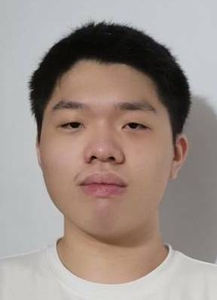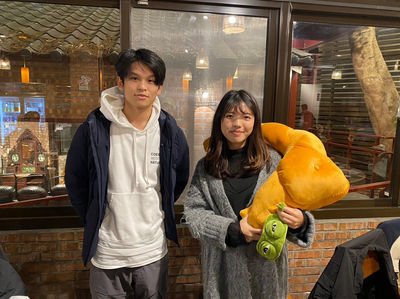
2023 Year-end party
17 Jan 2023
Tue
At the end of the year of Tiger, we went to a local restaurant at Hsinchu, which offers delicious Hakka delicacies. The advisor prepared a Playing Marbles game. Each student strived their own Year-end-bonuses by getting the scores and the luck for the year of Rabbit. Happy Lunar New Year!!!
Congratulate Master students on the Poster Award
12 Mar 2023
Sun
We congratulate Hsin-Jung, Wen-Jing, and Tsung-Ju on the Excellent Poster Prize at Annual Meeting of Chemical Society Located in Taipei, 2023.
Congratulate Zih-Yi and Wen-Jing on the Awards
19 May 2023
Fri
We congratulate Zih-Yi on the Gold Award and Wen-Jing on the Best Poster Award at the 3rd Symposium on Nano-Device Circuits and Technologies, 2023.
Congratulate Prof. Hung on the Award
26 May 2023
Fri
We congratulate Prof. Hung as a winner of the Green Chemistry Application and Innovation Award, 2023 for his contribution of the Green Chemistry.
Congratulate Master Students on the Award
26 May 2023
Fri
We congratulate Tsung-Ju, Hsin-Jung, and Zih-Yi winning the Gold Award at the 3rd College Green Chemistry Creative Competition, 2023.
Prof. Hung's corresponding paper in Adv. Energy Mater.
17 Jun 2023
Sat
Prof. Hung published "Active Site Tailoring of Metal-Organic Frameworks for Highly Efficient Oxygen Evolution" as the corresponding author in Advanced Energy Materials.
The following is the publication information:
Hu, F.; Yu, D.; Zeng, W.-J.; Lin, Z.-Y.; Han, S.; Sun, Y.; Wang, H.; Ren, J.; Hung, S.-F.;* Li, L.;* Peng, S.* Active Site Tailoring of Metal-Organic Frameworks for Highly Efficient Oxygen Evolution. Adv. Energy Mater. 2023, 13, 2301224.
https://onlinelibrary.wiley.com/doi/10.1002/aenm.202301224
Abstract:
The direct correlation between active sites and catalytic activity in multiple-component metal-organic frameworks (MOFs) is key to understanding their mechanism of oxygen evolution reaction (OER) but remains vague. Herein, supported multiple-site MOFs are adopted as model catalysts to quantitatively study the composition-dependent OER performance. Ni MOFs on Fe metal substrate possess the highest intrinsic OER activity with the Ni/Fe ratio of 1:2 in the presence of metal leaching of the substrate during synthesis. Further introducing a proper amount of Cu further boosts the OER performance of Cu-doped NiFe MOFs with an impressively low overpotential of 200 mV at 10 mA cm−2. Spectroscopic analysis with theoretical study indicates that the copper doping within the NiFe MOFs induces electron redistribution for high valence Fe sites with an optimized balance of OH/OOH adsorption and decreased energy barrier for improved OER. This work sheds light on the active site tailoring of MOFs which highly correlates with the OER activity.
Congratulate Wen-Jing on the Award
26 May 2023
Fri
We congratulate Wen-Jing on winning Merck Young Scientist - Rising Star Award, 2023.
Congratulate Hsin-Jung on the Award
9 Jun 2023
Fri
We congratulate Hsin-Jung on winning Graduate Student Thesis Award - Distinguished Honor, 2023.
Prof. Hung's corresponding paper in ACS Nano
20 Jun 2023
Tue
Prof. Hung published "Nanograin boundary-abundant Cu2O-Cu Nanocubes with High C2+ Selectivity and Good Stability during Electrochemical CO2 Reduction at a Current Density of 500 mA/cm2" as the corresponding author in Advanced Energy Materials.
The following is the publication information:
Wu, Q.;† Du, R.;† Wang, P.; Waterhouse, G. I.N.;* Li, J.; Qiu, Y.; Yan, K.; Zhao, Y.; Zhao, W.-W.; Tsai, H.-R.; Chen, M.-C.; Hung, S.-F.;* Wang, X.;* Chen, G.* Nanograin boundary-abundant Cu2O-Cu Nanocubes with High C2+ Selectivity and Good Stability during Electrochemical CO2 Reduction at a Current Density of 500 mA/cm2. ACS Nano 2023, 17, 12884-12894. (†These authors equally contribute to this work)
https://pubs.acs.org/doi/abs/10.1021/acsnano.3c04951
Abstract:
Surface and interface engineering, especially the creation of abundant Cu0/Cu+ interfaces and nanograin boundaries, is known to facilitate C2+ production during electrochemical CO2 reductions over copper-based catalysts. However, precisely controlling the favorable nanograin boundaries with surface structures (e.g., Cu(100) facets and Cu[n(100)×(110)] step sites) and simultaneously stabilizing Cu0/Cu+ interfaces is challenging, since Cu+ species are highly susceptible to be reduced into bulk metallic Cu at high current densities. Thus, an in-depth understanding of the structure evolution of the Cu-based catalysts under realistic CO2RR conditions is imperative, including the formation and stabilization of nanograin boundaries and Cu0/Cu+ interfaces. Herein we demonstrate that the well-controlled thermal reduction of Cu2O nanocubes under a CO atmosphere yields a remarkably stable Cu2O-Cu nanocube hybrid catalyst (Cu2O(CO)) possessing a high density of Cu0/Cu+interfaces, abundant nanograin boundaries with Cu(100) facets, and Cu[n(100)×(110)] step sites. The Cu2O(CO) electrocatalyst delivered a high C2+ Faradaic efficiency of 77.4% (56.6% for ethylene) during the CO2RR under an industrial current density of 500 mA/cm2. Spectroscopic characterizations and morphological evolution studies, together with in situtime-resolved attenuated total reflection–surface enhanced infrared absorption spectroscopy (ATR-SEIRAS) studies, established that the morphology and Cu0/Cu+ interfacial sites in the as-prepared Cu2O(CO) catalyst were preserved under high polarization and high current densities due to the nanograin-boundary-abundant structure. Furthermore, the abundant Cu0/Cu+ interfacial sites on the Cu2O(CO) catalyst acted to increase the *CO adsorption density, thereby increasing the opportunity for C–C coupling reactions, leading to a high C2+ selectivity.
Congratulate Master Students on Accomplishing the Defenses
28 Jun 2023
Wed
We congratulate Hsin-Jung, Wen-Jing, Zih-Yi, and Tsung-Ju on accomplishing Master defenses. We also thank Prof. Chih-Rung Chen at National Taiwan University and Prof. Tsu-Chin Chou at Tsing Hua University as the committee members gave valuable suggestions on the theses.
Congratulate Master Students on the Awards
29 Jun 2023
Thu
We congratulate Wen-Jing on winning the Outstanding Poster Award, and Tsung-Ju and Zih-Yi on winning the Honorable Poster Award at the Taiwan International Conference on Catalysis, 2023.
2023 Teacher Appreciation Banquet
20 Jul 2023
Thu
The graduate students hold the Teacher Appreciation Banquet for thanking Prof. Hung. We had a wonderful time at the Caiyuan Shanghai Restaurant. The graduate students prepared a gift to Prof. Hung, meaning "invincible". Thanks the graduate students.
Prof. Hung's corresponding paper in J. Am. Chem. Soc.
20 Jun 2023
Tue
Prof. Hung published "Dealloying Induced Zeolite-like Metal Framework of AB2 Laves Phase Intermetallic Electrocatalysts" as the corresponding author in Journal of the American Chemical Society
The following is the publication information:
Ji, S.-J.; Cao, L.-W.; Zhang, P.; Wang, G.-B.; Lu, Y.-R.; Suen, N.-T.;* Hung, S.-F.;* Chen, H. M.* Dealloying Induced Zeolite-like Metal Framework of AB2 Laves Phase Intermetallic Electrocatalysts. J. Am. Chem. Soc. 2023, accepted.
https://pubs.acs.org/doi/10.1021/jacs.3c05287
Abstract:
Exploring an efficient and robust electrocatalyst for hydrogen evolution reaction (HER) at high pH and temperature holds the key to the industrial application of alkaline water electrolysis (AWE). Herein, we design an open tunnel structure by dealloying a series of Laves phase intermetallics, i.e., MCo2 and MRu0.25Co1.75 (M = Sc and Zr). The dealloying process can induce a zeolite-like metal framework for ScCo2 and ScRu0.25Co1.75 by stripping Sc metal from the center of a tunnel structure. This structural engineering significantly lowers their overpotentials at a current density of 500 mA/cm2 (η500) ca. 80 mV in 1.0 M KOH. Through a simple process, ScRu0.25Co1.75 can be easily decorated on a carbon cloth substrate and only requires 132 mV to reach 500 mA/cm2. More importantly it can maintain activity over 1000 h in industrial conditions (6.0 M KOH at 333 K), showing its potential for practical industrial applications.
Welcome new members to join Hung's lab
31 Jul 2023
Mon
We welcome graduate students Yu-Ting, Yu-Chia, Yung-Hsi, and Yu-Chun, and undergraduate students Shuo-Peng, Ching-Ya, and Chi Kang to join Hung's lab. We hope that they can see and learn different knowledge and technologies in Hung's lab. We also hope that they can find their independent study soon.
Welcome party for the 2o23 new blood
1 Aug 2023
Tue
In this year, we have recruited graduate students Yu-Ting, Yu-Chia, Yung-Hsi, and Yu-Chun, and undergraduate students Shuo-Peng, Ching-Ya, and Chi Kang to join Hung's lab. We held a welcome party at an Amazing Hall restaurant. We hope they had a good time at the night that belongs to them. We also enjoyed the karaoke and sang many songs together. We also hope they get used to Hung's lab and grab what they desire here.
Congratulate 2023 New blood on finishing training
18 Aug 2023
Fri
Congratulate Yu-Ting, Yu-Chia, Yung-Hsi, and Yu-Chun on completing 26 hours VLSI training courses - Nano Metrology Technology and passing the examinations. We hope that they have learned knowledge regarding SEM, TEM, XRD, XPS, and AFM, and utilize what they learned to their researches.
Congratulate Jian-Jie on the Award
28 Oct 2023
Sat
We congratulate Jian-Jie on winning Honorable Mention for poster competition in electrochemical driven conversion at International Conference on Green Electrochemical Technologies.
Congratulate Kang-Shun on the Award
16 Nov 2023
Thur
We congratulate Kang-Shun on winning Lam Research Outstanding Science Scholarship.
2023 Christmas Party
21 Dec 2023
Thu
We went back to a restaurant we visited last year to held a Christmas party. Hung's Lab like the gorgeous roast ducks with two ducks and five eats, seafood, and Hakka food.We also had a gift-exchange game. All of them showed the creativity to prepare gorgeous gift. We had a wonderful time in this Christmas party.

















































































































